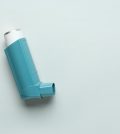- For Some, ‘Tis the Season for Loneliness. Experts Offer Tips to Stay Connected
- Taking a GLP-1 Medication? Here’s Tips to Holiday Eating
- Bird Flu Virus in Canadian Teen Shows Mutations That Could Help It Spread Among Humans
- Flu, COVID Vaccination Rates Remain Low as Winter Nears
- ’10 Americas:’ Health Disparities Mean Life Expectancy Varies Across U.S.
- Short-Term Hormone Therapy for Menopause Won’t Harm Women’s Brains
- Could a Vitamin Be Effective Treatment for COPD?
- Woman Receives World’s First Robotic Double-Lung Transplant
- Flavored Vapes Behind Big Surge in U.S. E-Cigarette Sales
- Reading Beyond Headline Rare For Most on Social Media, Study Finds
Dramatic Rise in Eye Injuries From BB and Paintball Guns

Popularized in movies, the phrase, “You’ll shoot your eye out,” is often repeated jokingly whenever someone talks about BB or paintball guns.
But it’s no laughing matter. These “non-powder” guns can cause serious, life-altering injuries, and these injuries are now happening far more often.
In fact, a new study found that while the overall rate of injuries due to BB and paintball guns has dropped around half since 1990, the rate of eye injuries has risen by 30%.
“These findings raise a red flag. Non-powder firearm injuries are among the most serious injuries we see to the eye, with fireworks a close second,” said study senior author Dr. Gary Smith, who directs the Center for Injury Research and Policy at Nationwide Children’s Hospital in Columbus, Ohio.
People sometimes dismiss these types of firearms as “toy” or “starter” guns, but Smith said they can cause very serious injuries, and even deaths.
“I’ve seen a BB gun penetrate the chest. I’ve seen a pellet gun penetrate the skull. Eye injuries from non-powder firearms can result in partial or complete blindness,” Smith said.
Non-powder firearms include BB, pellet, airsoft and paintball guns. These guns use air pressure, carbon dioxide pressure or a spring-loaded mechanism to shoot. They may propel metal or plastic projectiles of varying shapes and sizes. The speed at which these guns shoot varies, according to background information in the study.
These guns are typically used for target shooting, small animal hunting and recreational combat simulations (paintball and airsoft), the study authors said.
There are no federal regulations guiding the use of these guns. Smith said that about half of states have laws regarding the use of non-powder guns, but they’re quite variable.
The researchers used a large national database that tracks injuries in children under 18 treated in U.S. emergency departments. From 1990 through 2016, the researchers found reports of more than 364,000 non-powder gun injuries in children serious enough to warrant an emergency room visit — that’s an average of nearly 13,500 children each year.
About 7% of the children injured by non-powder guns needed to be admitted to the hospital.
Eighty-seven percent of the injuries occurred in boys. Most of the injuries occurred in children aged 6 to 17. The average age of those injured was 12. Most injuries occurred at home.
The head and neck area was the most commonly injured — about 40% of injuries occurred in this area. Upper extremities, such as the arms, were the next most injured area. Eye injuries accounted for almost 15% of all non-powder firearm injuries.
BB guns were responsible for 81% of injuries, followed by pellet guns causing 15.5% of the injuries. Paintball guns caused about 3% of injuries, while airsoft guns caused less than 1%.
Dr. Teresa Amato, chair of emergency medicine at Northwell Health’s Long Island Jewish Forest Hills Hospital, said, “Despite the fact that the number of injuries declined over the study time period, there was a substantial increase — over 30% — in eye injuries. There were nearly 54,000 eye injuries during the study period.” She was not involved with the study, but reviewed the findings.
Amato noted some of the eye injuries were minor, but some were quite severe, causing partial and sometimes total vision loss.
“Over 20% of these eye injuries required hospitalization for further management and treatment. It is very uncommon for eye injuries to require such hospitalization, but non-powder firearm eye injuries are the leading cause of eye injury hospitalization in pediatrics,” she explained.
Both experts recommended using protective eyewear when using these guns. If a child does sustain an injury to the eye, Amato said emergency care is needed to make sure the eye isn’t seriously injured.
Some states have laws about when children can have these types of guns, but Smith suggested letting your child’s maturity level be a guide. “Children develop at different rates, so there’s no clear consensus on what age a child is developmentally able to handle a potentially fatal non-powder firearm,” he said.
In addition to wearing eye protection, Smith said kids must be appropriately trained in how to use the gun safely. Children also must be supervised when using these guns, though it may be possible to eventually back off on supervision as a child matures.
The bottom line, Smith said, is “Don’t take these weapons lightly.”
The findings were published Nov. 25 in Pediatrics.
More information
Learn more about non-powder gun safety from Nationwide Children’s Hospital.
Source: HealthDay
Copyright © 2024 HealthDay. All rights reserved.



-120x134.jpg)





